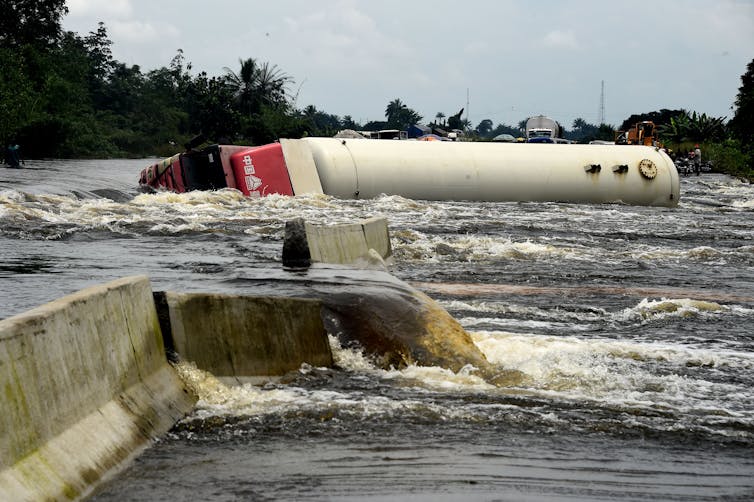
Victor Ongoma, Université Mohammed VI Polytechnique and Victor Nnamdi Dike, Chinese Academy of Sciences
Nigeria is one of the most flood-prone countries in west Africa. Many areas experience annual flooding. This happens during heavy rainfall and one of the reasons is poor drainage systems.
The country therefore needs to make improvements. As researchers who have specialised in meteorology for about two decades we believe there are several ways it can do this. The key interventions needed are:
understanding the impact of climate change on rainfall extremes and water resources
investing in a functional weather forecast system
addressing the problem of poor drainage.
These actions are necessary to build resilience to floods.
The Nigeria Meteorological Agency and the Nigeria Hydrological Services Agency have predicted severe flooding this year. And recent devastating flooding incidents are still fresh in the minds of Nigerians.
Flooding in Nigeria
Flash floods are considered the deadliest hazards related to extreme weather. Nigeria is increasingly prone to them.
There are many predictors of floods, chief of which is increasingly heavy rains over the west African Sahel.
In recent decades parts of Nigeria have experienced summer rainfall extremes that are more intense than before. Even dry regions like the Lake Chad River basin have begun to have record rainfalls. Downpours have submerged land areas, overrun watersheds and threatened the carrying capacity of water reservoirs.
This is expected to get worse as a result of global warming, according to a recent scientific study by the World Weather Attribution scientific team.
The atmospheric rivers linked to the recent heavy rainfall over the region are associated with a warmer north Atlantic and Mediterranean. The warming is connected with sea surface temperature anomalies in the tropical Pacific Ocean, described as Trans-Atlantic-Pacific Ocean Dipole.
Studies have also shown that La Niña events, periodically cool ocean surface temperatures in the central and east-central equatorial Pacific. The cooling is coupled with changes in winds and pressure that cause increased rainfall over the west African Sahel. More disturbing is the rare “triple-dip” La Niña climate event. Three consecutive years of these events will trigger more rainfall than normal in some regions.
The second set of drivers is geographical. For example low-land and coastal areas are flood risk areas because of rising river levels. Previous flood disasters have shown that these areas are disaster prone.
Thirdly, flooding in Nigeria is made worse by the poor management of drainage systems. The combination of heavy rains and nonexistent or poor drainage system increases the likelihood of flash floods in cities.
Adding to the problem are poor waste disposal, poor urban planning, tarmacking of urban roads and construction of drainage systems without climate adaptation in mind.
Building resilience against floods
There’s no way to influence rainfall variability, especially in the short term. But green engineering can help protect humans and the environment.
There are two strategies that Nigeria can easily use. They are proper dam management and tree planting. These initiatives will reduce the speed of water flow and reduce the impact of floods.
Another easy intervention is the process of risk mapping, assessment and planning for floods. This informs how resources should be distributed and how to reduce risk. It has been successful in countries such as Romania and Bulgaria.
Then there is forecasting. It is a complex process that is continually being improved as artificial intelligence and machine learning are incorporated into the prediction technologies. Capacity building is required to improve the reliability of forecasting in the country.
Both the Nigeria Hydrological Services Agency and the Nigerian Meteorology Agency provide timely precipitation forecasts for water-related disaster management. The World Meteorological Organisation has supported forecasting services in west Africa through its Severe Weather Forecasting Demonstration Project. The project would be more beneficial if it operated in all meteorological centres across the country.
For weather forecasting to deliver quality data, there is a need to continuously invest in equipment and review performance. For instance, the NigeriaSat-2 was built to provide high-resolution imagery of the Earth’s surface but it’s past its design life.
Drainage systems can be developed and improved by channels or ditches, and piping that directs excess rainwater and sewage to a point of disposal. Sustainable urban drainage systems are becoming common given their multiple benefits such as reducing the effects of pollution.
Lastly, financing has stood out as a challenge. Nigeria’s government needs to make good use of the climate change loss and damage fund that was established at the COP27 meeting. Access to the funding depends on having systems for data collection, recording and reporting of loss and damage finance needs.
Avoiding a repeat of disaster
Past floods are still fresh in people’s minds. In 2012, the destructive effect of the excess water released from the Lagdo Reservoir in northern Cameroon and torrential summer rainfall killed 400 people, displaced millions of others, and destroyed over 152,575 hectares of farmland in Nigeria. The Nigerian Emergency Management Agency) estimated a total economic loss to be about US$16.9 billion.
In 2022, the flooding caused over 600 deaths and affecting an estimated 3.2 million people across 34 of the country’s 36 states. The floods destroyed over 569,251 hectares of farmland.
As the 2023 flooding approaches, it is important for federal government and state agencies to work in coordination, following the seasonal climate forecast updates issued by the Nigerian Meteorological Agency. As a matter of urgency, states should set up local disaster management committees to assist in creating awareness and relocating communities living in flood-prone areas.![]()
Victor Ongoma, Assistant Professor, Université Mohammed VI Polytechnique and Victor Nnamdi Dike, Associate research scientist, Chinese Academy of Sciences
This article is republished from The Conversation under a Creative Commons license. Read the original article.

